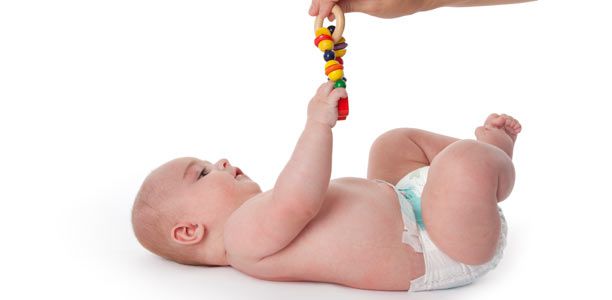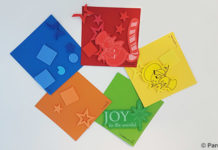Fine motor skills, the ability to control the movements of the hands and fingers develop early in life. Baby development milestones for fine motor skills are the things most babies can do with their fingers and hands at a particular age.
Babies 6 months
By six months of age most babies will be:
- Reaching out for objects they see around them.
- Swiping their arms to try and grab close objects, for example a rattle or toy you dangle in front of them.
- Holding objects placed in their hand so they do not fall.
- Using all their fingers to grasp objects in their palm, initially on the ulner (little finger) side and later in the middle of the palm.
- Grabbing objects like rattles.
- Holding onto objects for short periods of time.
- Showing an interest in toys that make noises.
- Grabbing and clasping small body parts including their own toes and your fingers.
- Playing with objects of different sizes.
Babies 12 months
By twelve months of age babies are usually:
- Reaching for and grasping objects using only one hand.
- Having lots of fun throwing the things they pick up and back down on the floor.
- Holding and shaking things that make noise like rattles and keys.
- Moving objects from one hand to another (and often also to their mouths).
- Interested in looking at the things they pick up.
- Holding objects in both hands at the same time.
- Raking objects by bending their fingers around objects and pulling them towards their palm (raking grasp).
- Picking objects between the pads of the thumb and index and middle fingers (radial digital grasp).
- Bang toys or other objects together and scrunch up paper. They will enjoy hearing the noises their actions make as they are coordinating not only their hands and eyes at this age, but also their sense of hearing.
- Clasp their hands together.
- Follow a moving person with their eyes, an important early step in developing hand eye coordination.
- Feeding themselves finger foods like rusks.
- Having a go at feeding themselves with a baby spoon, which they clench in their fist (and probably missing their mouth and making a mess in the process).
- Holding and manipulating their own bottle.
Babies 18 months
By eighteen months most babies will already be:
- Picking up small objects using pincer grip (grasping an object between the pads of the thumb and index finger).
- Holding fat pencils or crayons in their fist and scribbling.
- Turning thick book pages two or three at a time.
- Playing peg board games.
- Turning knobs and buttons.
- Finger feeding themselves efficiently.
- Self-feeding with baby utensils like a fork (and getting more and more food in their mouth).
- Drinking from a cup with no lid.
- Point at things they want to touch but can’t reach.
- Remove and replace things like toys and blocks from boxes or bins.
Free download
 |
Download printable checklist. |
You might also like…
 |
Fine motor skills for babies – birth to 18 months old. |
 |
Fine motor skills. |
References
- Virginia Early Childhood Development Alignment Program. Milestones of child development- A guide to young children’s learning and development from birth to kindergarten. 2009. (cited 12 May 2014). Available from URL Link
- Community Childcare Cooperative Ltd (NSW). Development Milestones and the Early Years Learning Framework and the National Quality Standards. Australian Government Department of Education, Employment and Workplace Relations. 2012. (cited 5 May 2014). Available from URL Link
- South Carolina Education Office of Early Childhood Education. South Carolina Infant and Toddler Guidelines. 2010. (cited 12 May 2014). Available from URL Link
- Owens A. Supporting children’s development- fine motor skills. Putting Children First. Issue 28. 2008. National Childcare Accreditation Council. [Full Text]
- Columbia University. Developmental Progression of the Grasp. UNDATED. (cited 4 September 2014). Available from URL Link
- Advertisement -
Date Created: November 5, 2014
Date Modified: July 3, 2018 


 (5 votes, average: 4.20 out of 5)
(5 votes, average: 4.20 out of 5) 






